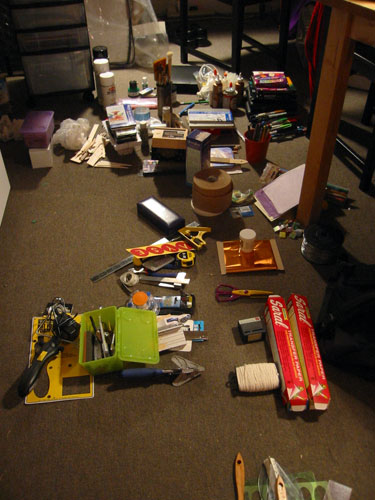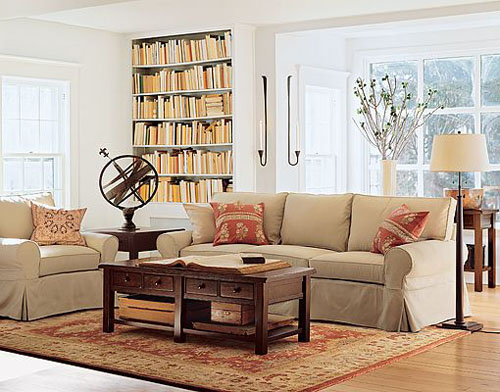One of the difficulties people have in decluttering their houses is really, deep-down wanting to get rid of stuff. Because you cannot declutter a house and not take anything out of it; clutter is unnecessary stuff, not critical stuff that is just in the wrong spot or not organized.
Some of the resistance is just low-energy. I know that I've had whole months when I ignored a stack of things I needed to go through and deal with because I just did not feel like it. There are many techniques for learning how to declutter around that sort of depressive energy level, mostly involving breaking the task down into small pieces and making consistent if slow progress.
But some of the resistance is the belief that this stuff is important. There are any number of common justifications for why this stuff has to be sorted and organized rather than thrown away or given away.
The Environment
This is my favourite, because it's so completely ironic. Usually I hear this one about a stack of margarine containers that reaches the ceiling, or a sack of plactic grocery bags. The argument goes like this: "I need to save this to keep it out of the landfill, or because reuse is better than recycling, or some other bogus reason." OK, yeah, I have a bad attitude about this excuse.
Reuse is better than recycling, but reducing is better than reusing. If it bothers you that margarine tubs might end up in the landfill, don't buy margarine in tubs. Buy it in sticks and mash or whip the stick into a tub yourself, if you must have whipped margarine or butter or whatever all that stuff in the tubs is.
The key is to not bring the stuff into the house to begin with.
Once you've got your leaning tower of containers, you have to deal with the consequences of your actions. Find a plastics recycling place or just throw the things out, but get rid of all but a couple, if you actually ever use any. If, for some reason, you should need more plastic containers, you can always buy some more margarine or just buy a plastic container.
Caretaker of the Inheritance
This is another good excuse. It goes like this: "I don't like this armoire, but my kids might need it when they get a home of their own, so I'm keeping it." This is funniest when the kids in question are not born yet, but you also hear it when the kids in question are 35 and obviously have no need or desire to take the armoire.
There are two things at play here. First of all, your house doesn't have to be a storage facility for your children. If you hate the thing, get rid of it. Either sell it, give it away, or store it offsite, although the latter is an extreme measure, only to be used when the item in question is a priceless heirloom. If the kids are grown up and might want it, ask them. If they say they want it, deliver it to them; if they don't want it, get rid of it.
Second, not every piece of furniture or dishware or anything is worthy of being an heirloom. Even a piece with a lot of sentiment attached to it might not stand the test of time; I had a nice little chair that had been in our TV room when I was a kid, and I dragged it around with me for years until it literally fell apart. Yeah, it was part of my childhood. No, it was not worth throwing time and money into repairing.
Sentimentality
Which brings me to one of the biggest reasons people have for resisting getting rid of stuff. "It was my grandmother's!" or "that was a wedding present!"
The first step beyond this excuse is to realize that you can love somebody and remember them without filling your house with everything they ever gave you, or trinkets and bric-a-brac that they accumulated in their lifetime. When somebody gives you a gift that is just not your style, thank them kindly and get rid of it discreetly. The worst possible scenario is that every time you look at that ugly vase you are reminded of your favourite aunt and feel guilty for hating it so much. Getting rid of the thing lets all your thoughts of your aunt be happy and fond, rather than bad and guilty.
The next step is to find your positive mementos and make them shine. Ha! Bet you didn't expect that! Yes, you should have things you love and that remind you of people and events you loved around your house. Don't hide them behind lots of stuff you don't love: clear out the clutter and bring them to the front. If you have fourteen thousand photos in a box, and there are two great shots in there, getting rid of the 13,998 photos that are at odd angles or too far away or fuzzy or grainy and then framing and displaying the two you love will make you life and house a lot better.
Last summer I threw away about 2,000 old photos. Not just the photos, but the negatives, too, because why do I need to save the negatives for shots that didn't work out? I saved the 20 or so images that I really loved, and their negatives, for framing and hanging on the wall. I also threw out a few dozen playbills and ticket stubs from events years ago that I barely remembered; I never recheck those or even look at them, and they were taking up space. In their place I put my sketchbooks up on the shelf they had been occupying, where I can take them down to look through for inspiration.
There can only be so many areas of focus in a house. Make yours count.
Archivist for the Ages
The last, and most compulsive, excuse I hear about clutter is that "this has historical value," or worse, "it's a collector's item."
If you want to invest in something that will make you lots of money, buy stock. "Collectibles" are a gamble that other people will not be saving this stuff, and it will be both rare and desirable in your lifetime. From what I can see of the market, if the people who made so much money on Star Trek memorabilia had instead bought Proctor and Gamble stock of the same value and held it as long, they would have made many times over what they made on selling the junk they were toting around, and they would not have had to store it in their living space in the mean time.
So sell off the collectibles now and invest in something of real value. Having a bunch of stuff in your house that you can't use lest it lose value is a horrible thing. The big test is this: will you take it out of the box and throw the box away? If not, it should get out of the house.
The other big trap is the historical items trap, and I know this one well myself, because as we restore our house we keep finding all sorts of detritus left behind by previous owners and even the people who built the house. It's tempting to keep it all and somehow display it in the house, but who wants to live in a museum? And that's what it would be like if we set up glass display cases and filled them with things like rusty square nails and razor wrappers from 1876.
We chose a few things that seemed whimsical to us: a chisel somebody dropped into the wall in the front bay during the original construction on the house, a few nails, some bottles dug out of the trash pits in the yard. The rest we're either giving away or throwing away. After all, we have the house. We don't need to save every bit of ephemera that came with it.
One of the things people who are afflicted with the obsessive need to save ephemera (playbills, ticket stubs, letters, and so forth) forget is that the value of that stuff from the past lies in its very disposable nature. A letter that survived seems more important because it is rare; a huge collection of letters quickly loses any excitement. Our lives, day to day, are actually quite dull, and they only seem exciting when we pick and choose the good parts to save for posterity. So feel free to edit your ephemera: lose the boring letters about what the climate is like in England from your old pen-pal, but keep that love note from your first boyfriend who ended up in a political scandal.
There are a million excuses for keeping clutter around. Most of them are just excuses, not really good, justifiable reasons. When you're not sure whether you're just making excuses, examine why you're justifying keeping the item. Is it because you really love it and can't bear to let it go? Or is it because it's "neat," or you feel guilty about getting rid of it, or you think it has value to some other person? Looking at your reasons for the reasons can help you get rid of stuff.

